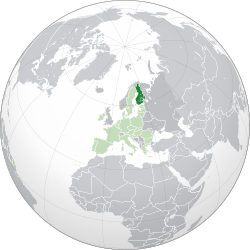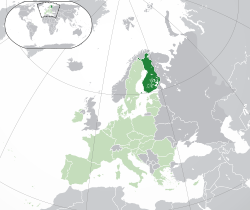ປະເທດແຟງລັງ
ແຟງລັງ (ແຟງລັງ: Suomi [suo̯mi] (![]() ຟັງສຽງ); ຊູແອດ: Finland [ˈfɪnland] (
ຟັງສຽງ); ຊູແອດ: Finland [ˈfɪnland] (![]() ຟັງສຽງ)) ມີຊື່ເອີ້ນຢ່າງເປັນທາງການແມ່ນ ສາທາລະນະລັດ ແຟງລັງ (ແຟງລັງ: Suomen tasavalta; ຊູແອດ: Republiken Finland) ເປັນປະເທດໃນກຸ່ມນອກດິກ ຕັ້ງຢູ່ທາງຕາເວັນອອກສຽງເໜືອຂອງທະວີບເອີຣົບ ເຂດແດນດ້ານຕາເວັນຕົກສຽງໃຕ້ຕິດກັບທະເລບານຕິກ ທາງດ້ານໃຕ້ຕິດກັບອ່າວແຟງລັງ ທາງຕາເວັນຕົກຕິດກັບອ່າວບົດເນຍ. ປະເທດແຟງລັງມີຊາຍແດນຕິດກັບປະເທດຊູແອດ, ນອກແວ ແລະ ລັດເຊຍ ສຳລັບໝູ່ເກາະໂອລັນທີ່ຢູ່ຫ່າງຈາກຊາຍຝັ່ງຕາເວັນຕົກສຽງໃຕ້ນັ້ນ ຢູ່ພາຍໃຕ້ການປົກຄອງຂອງແຟງລັງ ແຕ່ເປັນເຂດປົກຄອງຕົນເອງ ເຄີຍຖຶກລັດເຊຍຍຶດຄອງ ແລະ ເປັນດິນແດນສ່ວນໜຶ່ງຂອງລັດເຊຍ. ເມືອງຫຼວງ ແລະ ເມືອງໃຫຍ່ທີ່ສຸດແມ່ນ: ເຮວຊິນກິ. ເມືອງສຳຄັນອື່ນໆມີເຊັ່ນ: ແອັດສະປູ, ວັນຕາ, ຕຳເປເຣ, ໂອລູ ແລະ ຕວັກກຸ.
ຟັງສຽງ)) ມີຊື່ເອີ້ນຢ່າງເປັນທາງການແມ່ນ ສາທາລະນະລັດ ແຟງລັງ (ແຟງລັງ: Suomen tasavalta; ຊູແອດ: Republiken Finland) ເປັນປະເທດໃນກຸ່ມນອກດິກ ຕັ້ງຢູ່ທາງຕາເວັນອອກສຽງເໜືອຂອງທະວີບເອີຣົບ ເຂດແດນດ້ານຕາເວັນຕົກສຽງໃຕ້ຕິດກັບທະເລບານຕິກ ທາງດ້ານໃຕ້ຕິດກັບອ່າວແຟງລັງ ທາງຕາເວັນຕົກຕິດກັບອ່າວບົດເນຍ. ປະເທດແຟງລັງມີຊາຍແດນຕິດກັບປະເທດຊູແອດ, ນອກແວ ແລະ ລັດເຊຍ ສຳລັບໝູ່ເກາະໂອລັນທີ່ຢູ່ຫ່າງຈາກຊາຍຝັ່ງຕາເວັນຕົກສຽງໃຕ້ນັ້ນ ຢູ່ພາຍໃຕ້ການປົກຄອງຂອງແຟງລັງ ແຕ່ເປັນເຂດປົກຄອງຕົນເອງ ເຄີຍຖຶກລັດເຊຍຍຶດຄອງ ແລະ ເປັນດິນແດນສ່ວນໜຶ່ງຂອງລັດເຊຍ. ເມືອງຫຼວງ ແລະ ເມືອງໃຫຍ່ທີ່ສຸດແມ່ນ: ເຮວຊິນກິ. ເມືອງສຳຄັນອື່ນໆມີເຊັ່ນ: ແອັດສະປູ, ວັນຕາ, ຕຳເປເຣ, ໂອລູ ແລະ ຕວັກກຸ.
ສາທາລະນະລັດ ແຟງລັງ
| |
|---|---|
ທີ່ຕັ້ງຂອງ ປະເທດແຟງລັງ (ຂຽວເຂັ້ມ) – ໃນເອີຣົບ (ຂຽວ & ເທົາເຂັ້ມ) | |
| ເມືອງຫຼວງ ແລະ ເມືອງໃຫຍ່ທີ່ສຸດ | ເຮວຊິນກິ 60°10′N 24°56′E / 60.167°N 24.933°E |
| ພາສາລັດຖະການ | |
| ພາສາປະຈຳຊາດ | |
| ກຸ່ມຊົນເຜົ່າ | |
| ສາສະໜາ (2020)[3] |
|
| ການປົກຄອງ | ລັດດ່ຽວ ສາທາລະນະລັດລະບົບລັດຖະສະພາ[4] |
| Sauli Niinistö | |
| Petteri Orpo | |
| ສະພານິຕິບັນຍັດ | ລັດຖະສະພາ |
| ເອກະລາດ ຈາກ ລັດເຊຍ | |
| 29 ມີນາ ຄ.ສ 1809 | |
| 6 ທັນວາ ຄ.ສ 1917 | |
| ມັງກອນ – ພຶດສະພາ ຄ.ສ 1918 | |
| 17 ກໍລະກົດ ຄ.ສ 1919 | |
| 30 ພະຈິກ ຄ.ສ 1939 – 13 ມີນາ ຄ.ສ 1940 | |
| 25 ມິຖຸນາ ຄ.ສ 1941 – 19 ກັນຍາ ຄ.ສ 1944 | |
| 1 ມັງກອນ ຄ.ສ 1995 | |
• ເຂົ້າຮ່ວມກັບນາໂຕ | 4 ເມສາ ຄ.ສ 2023 |
| ພື້ນທີ່ | |
• ລວມ | 338,455 ຕາລາງກິໂລແມັດ (130,678 ຕາລາງໄມລ໌) (ອັນດັບທີ 65) |
| 9.71 (ໃນປີ ຄ.ສ 2015)[5] | |
| ປະຊາກອນ | |
• 2020 ປະມານ | |
| 16 ຕໍ່ຕາລາງກິໂລແມັດ (41.4 ຕໍ່ຕາລາງໄມລ໌) (ອັນດັບທີ 213) | |
| GDP (ອຳນາດຊື້) | 2020 (ປະມານ) |
• ລວມ | 257 ຕື້ໂດລາສະຫະລັດ[7] (ອັນດັບທີ 60) |
• ຕໍ່ຫົວ | 49,334 ໂດລາສະຫະລັດ[7] (ອັນດັບທີ 19) |
| GDP (ລາຄາຕະຫຼາດ) | 2020 (ປະມານ) |
• ລວມ | 277 ຕື້ໂດລາສະຫະລັດ[7] (ອັນດັບທີ 43) |
• ຕໍ່ຫົວ | 48,461 ໂດລາສະຫະລັດ[7] (ອັນດັບທີ 14) |
| ຈີນີ (2019) | ຕ່ຳ · ອັນດັບທີ 6 |
| HDI (2019) | ສູງຫຼາຍ · ອັນດັບທີ 11 |
| ສະກຸນເງິນ | ເອີໂຣ (€) (EUR) |
| ເຂດເວລາ | UTC+2 (ເວລາເອີຣົບຕາເວັນອອກ) |
• ລະດູຮ້ອນ (ເວລາອອມແສງ) | UTC+3 (ເວລາອອມແສງເອີຣົບຕາເວັນອອກ) |
| ຮູບແບບວັນທີ | ວ.ດ.ປປປປ[10] |
| ຂັບລົດດ້ານ | ຂວາມື |
| ລະຫັດໂທລະສັບ | +358 |
| ລະຫັດອິນເຕີເນັດ | .fi, .axa |
| |
ແຟງລັງມີປະຊາກອນປະມານ 5.52 ລ້ານຄົນ (ຂໍ້ມູນໃນກາງປີ 2019)[11] ປະຊາກອນສ່ວນຫຼາຍອາໄສຢູ່ໃນພາກກາງ ແລະ ພາກໃຕ້ຂອງປະເທດ ແລະ ເວົ້າພາສາແຟງລັງ ເຊິ່ງເປັນກຸ່ມພາສາແຟງນິກຈາກຕະກຸນພາສາເອີຣານ ແລະ ບໍ່ມີຄວາມສຳພັນກັບພາສາສະແກນດິນາເວຍແຕ່ຢ່າງໃດ.[12] ປະເທດແຟງລັງເປັນປະເທດທີ່ໃຫຍ່ທີ່ສຸດອັນດັບທີ 8 ຂອງທະວີບເອີຣົບ ແລະ ເປັນປະເທດທີ່ມີປະຊາກອນເບົາບາງທີ່ສຸດໃນສະຫະພາບເອີຣົບ. ປະເທດແຟງລັງເປັນສາທາລະນະລັດໃນລະບົບລັດຖະສະພາທີ່ປະກອບດ້ວຍ 311 ເທສະບານ[13] ແລະ 1 ເຂດປົກຄອງຕົນເອງ ແມ່ນ ໝູ່ເກາະໂອລັນ ມີປະຊາກອນຫຼາຍກວ່າ 1.4 ລ້ານຄົນອາໄສຢູ່ໃນຂອບເຂດເກຣເຕີ ເຮວຊິນກິ ແລະ ຄິດເປັນ 1 ໃນ 3 ຂອງລວມຍອດຜະລິດຕະພັນພາຍໃນປະເທດ
ປະເທດແຟງລັງມີດັດຊະນີການພັດທະນາມະນຸດຕາມສະຖິຕິຂອງສະຫະປະຊາຊາດ ໃນປີ ຄ.ສ 2006 ຢູ່ໃນລຳດັບທີ 11.[14] ແຟງລັງເຄີຍເປັນສ່ວນໜຶ່ງຂອງຊູແອດຫຼາຍສະຕະວັດ ຫຼັງຈາກນັ້ນກໍຢູ່ພາຍໃຕ້ຈັກກະວັດລັດເຊຍຈົນເຖິງປີ ຄ.ສ 1917 ປັດຈຸບັນ ແຟງລັງເປັນສາທາລະນະລັດ ປະຊາທິປະໄຕ.
ພາສາແຟງລັງເປັນໜຶ່ງໃນພາສາທາງການ ພາສາຈໍານວນໜ້ອຍຂອງສະຫະພາບເອີຣົບ ທີ່ບໍ່ໄດ້ມີຕົ້ນກຳເນີດເປັນກຸ່ມພາສາອິນໂດ-ເອີໂຣປຽນ ຮ່ວມກັບພາສາແອັດສະໂຕນີ, ພາສາຮົງກາລີ ແລະ ພາສາມານຕາ.
ຕັ້ງແຕ່ປະມານ 2,700 ປີກ່ອນພຸດທະການ ດິນແດນແຟງລັງໄດ້ຮັບອິດທິພົນທາງວັດທະນະທຳຈາກພາກໃຕ້ຂອງອ່າວແຟງລັງ ໂດຍເຂົ້າມາທາງຕາເວັນຕົກສຽງໃຕ້ຂອງແຟງລັງ ມີຫຼັກຖານຂອງເຄື່ອງປັ້ນດິນເຜົາທີ່ມີລັກສະນະສະເພາະ ຕໍ່ມາໃນຍຸກສຳລິດ ພື້ນທີ່ທາງຊາຍຝັ່ງຂອງແຟງລັງໄດ້ຮັບອິດທິພົນຈາກສະກັງດີນາວີ ແລະ ເອີຣົບກາງ ໃນຂະນະທີ່ພື້ນທີ່ທີ່ຢູ່ຫ່າງຈາກທະເລເຂົ້າໄປ ໄດ້ຮັບອິດທະພົນການໃຊ້ສຳລິດມາຈາກທາງຕາເວັນອອກຫຼາຍກວ່າ[15] ໃນພຸດທະສະຕະວັດທີ 5 ພົບວ່າມີການຄ້າຂາຍແລກປ່ຽນກັບສະກັງດີນາວີຫຼາຍຂຶ້ນ ແລະ ການຄົ້ນພົບວັດຖຸແບບໂຣມັງຈາກຍຸກນີ້ດ້ວຍ ປາກົດການກ່າວເຖິງຊາງແຟງລັງໃນເອກະສານຂອງຊາວໂຣມັງໃນຊ່ວງກາງພຸດທະສະຕະວັດທີ 7[16]
ໃນອະດີດປະເທດແຟງລັງເປັນປະເທດກະສິກຳຈົນເຖິງປີ ຄ.ສ 1950 ພາຍຫຼັງສິ້ນສຸດສົງຄາມໂລກຄັ້ງທີສອງ ແຟງລັງໄດ້ພັດທະນາເສດຖະກິດຢ່າງວ່ອງໄວໂດຍການສ້າງລັດສະຫວັດດີການທີ່ມີຄຸນນະພາບຕາມຕົວແບບນອກຕິກ ສົ່ງຜົນໃຫ້ຄວາມຈະເລີນໄດ້ກະຈາຍໄປທົ່ວປະເທດ ແລະ ກາຍເປັນປະເທດທີ່ມີຄວາມຮັ່ງມີສູງຈົນເຖິງປັດຈຸບັນ.[17] ແຟງລັງເຂົ້າຮ່ວມເປັນສະມາຊິກສະຫະປະຊາຊາດໃນປີ ຄ.ສ 1995 ດ້ວຍຄວາມຕັ້ງໃຈໃນການວາງຕົວເປັນກາງທາງການເມືອງ[18] ແລະ ຍັງເຂົ້າຮ່ວມອົງການເພື່ອຄວາມຮ່ວມມື ແລະ ການພັດທະນາທາງເສດຖະກິດ, ກຸ່ມປະເທດຄວາມຮ່ວມມືເທື່ອສັນຕິພາບຂອງນາໂຕ (Partnership for Peace), ສະຫະພາບເອີຣົບ ແລະ ສະພາຄວາມຮ່ວມມືເອີໂຣ ແຟງລັງຍັງມີຈຸດເດັ່ນໃນເລື່ອງລະບົບການສຶກສາທີ່ມີຄຸນນະພາບ[19] ມີຄວາມສາມາດໃນການແຂ່ງຂັນທາງເສດຖະກິດໃນລະດັບສູງ ແລະ ໄດ້ຮັບການຍອມຮັບໃນດ້ານຄຸນນະພາບຊີວິດຂອງປະຊາກອນ[20][21] ໂດຍຖືເປັນໜຶ່ງໃນປະເທດທີ່ໃຫ້ສິດທິ ແລະ ເສລີພາບແກ່ປະຊາກອນໃນລະດັບສູງ ໃນປີ ຄ.ສ 2015. ແຟງລັງໄດ້ຮັບການຈັດອັນດັບຢູ່ໃນອັນດັບໜຶ່ງໃນດ້ານດັດຊະນີທຶນມະນຸດ (Human Capital Index)[22] ແລະ ເປັນປະເທດທີ່ມີສະຖຽນລະພາບຫຼາຍທີ່ສຸດໃນໂລກ ລະຫວ່າງປີ ຄ.ສ 2011-2016 ຈາກການວັດຕາມຄ່າດັດຊະນີ Fragile States Index[23] ແລະ ຍັງໄດ້ຮັບການຈັດອັນດັບວ່າເປັນປະເທດທີ່ປະຊາກອນມີຄວາມສຸກທີ່ສຸດໃນໂລກ.[24][25]
ອ້າງອີງ
- ↑ "11rv -- Origin and background country by sex, by municipality, 1990-2020". Statistics Finland. Archived from the original on 2022-06-01. Retrieved 21 August 2021.
- ↑ "United Nations Population Division | Department of Economic and Social Affairs". United Nations. Retrieved 29 June 2018.
- ↑ "Population". Statistics Finland. Retrieved 5 April 2021.
- ↑ Formerly a semi-presidential republic, it is now a parliamentary republic according to David Arter, First Chair of Politics at Aberdeen University. In his "Scandinavian Politics Today" (Manchester University Press, revised 2008 ISBN 978-0-7190-7853-8), he quotes Nousiainen, Jaakko (June 2001). "From semi-presidentialism to parliamentary government: political and constitutional developments in Finland". Scandinavian Political Studies. 24 (2): 95–109. doi:10.1111/1467-9477.00048. as follows: "There are hardly any grounds for the epithet 'semi-presidential'." Arter's own conclusions are only slightly more nuanced: "The adoption of a new constitution on 1 March 2000 meant that Finland was no longer a case of semi-presidential government other than in the minimalist sense of a situation where a popularly elected fixed-term president exists alongside a prime minister and cabinet who are responsible to parliament (Elgie 2004: 317)". According to the Finnish Constitution, the president has no possibility to rule the government without the ministerial approval, and does not have the power to dissolve the parliament under his or her own desire. Finland is actually represented by its prime minister, and not by its president, in the Council of the Heads of State and Government of the European Union. The 2012 constitutional amendments reduced the powers of the president even further.
- ↑ "Surface water and surface water change". Organisation for Economic Co-operation and Development (OECD). Retrieved 11 October 2020.
- ↑ "Birth rate showed a slight growth in 2020". Statistics Finland. Retrieved 21 January 2021.
- ↑ 7.0 7.1 7.2 7.3 "Report for Selected Countries and Subjects". IMF. 17 October 2018.
- ↑ "Gini coefficient of equivalised disposable income - EU-SILC survey". European Commission. Retrieved 27 March 2020.
- ↑ "Human Development Report 2020" (PDF) (in ອັງກິດ). United Nations Development Programme. 15 December 2020. Retrieved 15 December 2020.
- ↑ Ajanilmaukset Archived 20 ຕຸລາ 2017 at the Wayback Machine Kielikello 2/2006. Institute for the Languages of Finland. Retrieved 20 October 2017
- ↑ Tilastokeskus. "Population". www.tilastokeskus.fi (in ອັງກິດ). Retrieved 5 June 2018.
- ↑ "Finland in Figures: Population" (in ຟິນນິຊ). Population Register Centre. 27 March 2014. Retrieved 1 April 2014.
- ↑ "Kotisivu - Kuntaliiton Kunnat.net" (in ຟິນນິຊ). Suomen Kuntaliitto. Retrieved 6 May 2015.
- ↑ "Human Development Report 2006" (PDF) (in ອັງກິດ). ສຳນັກງານໂຄງການພັດທະນາແຫ່ງສະຫະປະຊາຊາດ. Archived from the original (PDF) on 2007-02-02. Retrieved 2007-03-31.
- ↑ Kirby, David (2006). A Concise History of Finland (in ອັງກິດ). Cambridge, UK: Cambridge University Press. ISBN 0-521-53989-7.
- ↑ Kallio, Veikko (1994). Finland: A Cultural Outline (in ອັງກິດ). Porvoo: WSOY. ISBN 951-0-19421-2.
- ↑ "World Economic Outlook Databases". IMF (in ອັງກິດ).
- ↑ NATO. "Relations with Finland". NATO (in ອັງກິດ).
- ↑ "Tertiary education graduation rates - Education: Key Tables from OECD - OECD iLibrary". web.archive.org. 2011-04-30. Archived from the original on 2011-04-30. Retrieved 2021-09-11.
{{cite web}}: CS1 maint: bot: original URL status unknown (link) - ↑ "Her er verdens mest konkurransedyktige land | Næringsliv | Makro og politkk | E24". web.archive.org. 2010-10-14. Archived from the original on 2010-10-14. Retrieved 2021-09-11.
{{cite web}}: CS1 maint: bot: original URL status unknown (link) - ↑ "Finland: World Audit Democracy Profile". web.archive.org. 2013-10-30. Archived from the original on 2013-10-30. Retrieved 2021-09-11.
{{cite web}}: CS1 maint: bot: original URL status unknown (link) - ↑ "Rankings". Human Capital Report 2015 (in ອັງກິດ (ອາເມລິກັນ)).
- ↑ "The Fragile States Index 2016 | The Fund for Peace". web.archive.org. 2017-02-04. Archived from the original on 2017-02-04. Retrieved 2021-09-11.
{{cite web}}: CS1 maint: bot: original URL status unknown (link) - ↑ CNN, By Katia Hetter. "This is the world's happiest country in 2019". CNN (in ອັງກິດ).
- ↑ https://happiness-report.s3.amazonaws.com/2020/WHR20.pdf
ອ່ານເພີ່ມເຕີມ
- Chew, Allen F. The White Death: The Epic of the Soviet-Finnish Winter War (ISBN 0-87013-167-2).
- Engle, Eloise and Paananen, Pauri. The Winter War: The Soviet Attack on Finland 1939–1940 (ISBN 0-8117-2433-6).
- Insight Guide: Finland (ISBN 981-4120-39-1).
- Jakobson, Max. Finland in the New Europe (ISBN 0-275-96372-1).
- Jutikkala, Eino; Pirinen, Kauko. A History of Finland (ISBN 0-88029-260-1).
- Klinge, Matti. Let Us Be Finns: Essays on History (ISBN 951-1-11180-9).
- Lavery, Jason. The History of Finland, Greenwood Histories of the Modern Nations, Greenwood Press, 2006 (ISBN 0-313-32837-4, ແມ່ແບບ:ISSN).
- Lewis, Richard D. Finland: Cultural Lone Wolf (ISBN 1-931930-18-X).
- Lonely Planet: Finland (ISBN 1-74059-791-5)
- Mann, Chris. Hitler's Arctic War: The German Campaigns in Norway, Finland, and the USSR 1940–1945 (ISBN 0-312-31100-1).
- Rusama, Jaakko. Ecumenical Growth in Finland (ISBN 951-693-239-8).
- Singleton, Fred. A Short History of Finland (ISBN 0-521-64701-0).
- Subrenat, Jean-Jacques. Listen, there's music from the forest; a brief presentation of the Kuhmo Chamber Music Festival (ISBN 952-92-0564-3).
- Swallow, Deborah. Culture Shock! Finland: A Guide to Customs and Etiquette (ISBN 1-55868-592-8).
- Trotter, William R. A Frozen Hell: The Russo-Finnish Winter War of 1939–1940 (ISBN 1-56512-249-6).
ແຫຼ່ງຂໍ້ມູນອື່ນ
- Finland. The World Factbook. Central Intelligence Agency.
- ປະເທດແຟງລັງ ທີ່ເວັບໄຊ Curlie
- Finland profile from the BBC News
- Key Development Forecasts for Finland from International Futures
- Population in Finland 1750–2010
- Appendix figure 2. The largest groups by native language 2001 and 2011 (Statistics Finland)
- Official statistical information about Finland from Findicator.
ລັດຖະບານ
- This is Finland, the official English-language online portal (administered by the Finnish Ministry for Foreign Affairs)
- Finland (University of Colorado Boulder Libraries Government Publications)
ແຜນທິ່
ການເດີນທາງ



